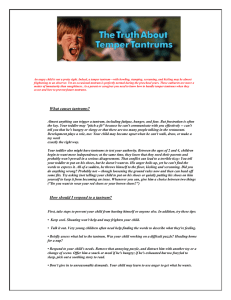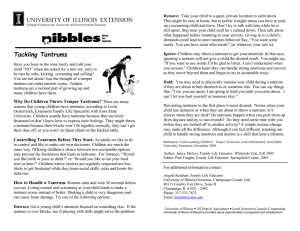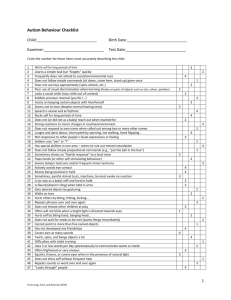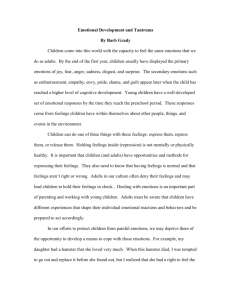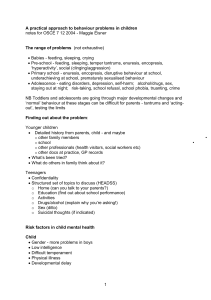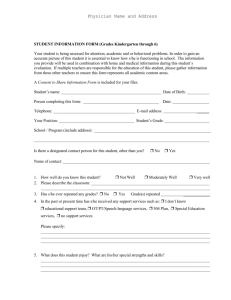Temper tantrums Preschoolers
advertisement
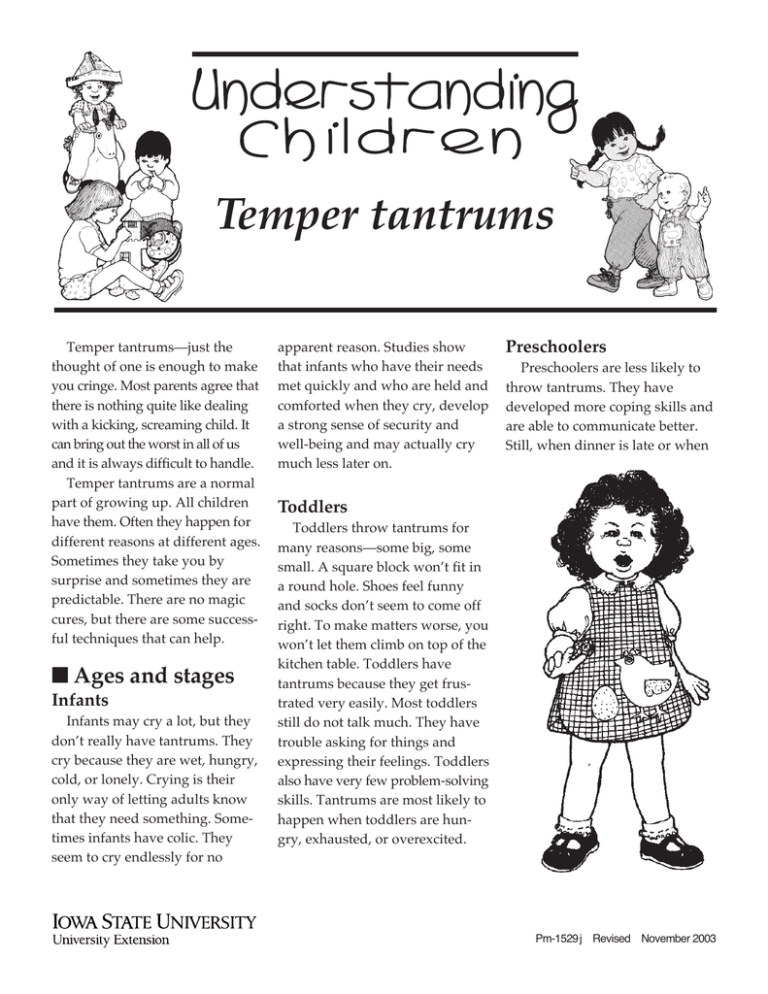
Temper tantrums Temper tantrums—just the thought of one is enough to make you cringe. Most parents agree that there is nothing quite like dealing with a kicking, screaming child. It can bring out the worst in all of us and it is always difficult to handle. Temper tantrums are a normal part of growing up. All children have them. Often they happen for different reasons at different ages. Sometimes they take you by surprise and sometimes they are predictable. There are no magic cures, but there are some successful techniques that can help. ■ Ages and stages Infants Infants may cry a lot, but they don’t really have tantrums. They cry because they are wet, hungry, cold, or lonely. Crying is their only way of letting adults know that they need something. Sometimes infants have colic. They seem to cry endlessly for no apparent reason. Studies show that infants who have their needs met quickly and who are held and comforted when they cry, develop a strong sense of security and well-being and may actually cry much less later on. Preschoolers Preschoolers are less likely to throw tantrums. They have developed more coping skills and are able to communicate better. Still, when dinner is late or when Toddlers Toddlers throw tantrums for many reasons—some big, some small. A square block won’t fit in a round hole. Shoes feel funny and socks don’t seem to come off right. To make matters worse, you won’t let them climb on top of the kitchen table. Toddlers have tantrums because they get frustrated very easily. Most toddlers still do not talk much. They have trouble asking for things and expressing their feelings. Toddlers also have very few problem-solving skills. Tantrums are most likely to happen when toddlers are hungry, exhausted, or overexcited. Pm-1529j Revised November 2003 things get frustrating, your preschooler may begin to behave more like a 2-year-old! Some children learn at this age that tantrums can be used to get something they want. If parents give in to demands, tantrums may begin to occur with greater frequency. School-agers Older children are typically more tolerant of frustrating situations, but they too get overly tired, hungry, and irritable. Although school-age children have developed stronger problem-solving skills, they are faced with increasingly complex social situations, and need to refine their problem-solving skills. Learning to get along with friends, work as part of a team, or compete in a sport requires skills that many older kids haven’t fully developed yet. Kids who have limited problem-solving skills or difficulty expressing themselves with words are more likely to have temper tantrums or fits of anger. Older children can learn to recognize when they are feeling upset or frustrated. Also, they can learn acceptable ways to deal with their anger. ■ How to handle a tantrum 1. Try to remain calm. Shaking, spanking, or screaming at your child tends to make the tantrum worse instead of better. Set a positive example for your child by remaining in control of yourself and your emotions. 2. Pause before you act. Take at least 30 seconds to decide how you will handle the tantrum. Four possible ways to deal with a tantrum include: Distract—Try to get your child’s attention focused on something else. If your child screams when you take away something unsafe (like mommy’s purse) offer something else to play with. This technique works well with toddlers. Remove—Take your child to a quiet, private place to calm down. At home this may be the child’s room or a special “cooling down” place. Out in public it may mean sitting outside for a few minutes or in the car. Avoid trying to talk or reason with a screaming child. It doesn’t work! Stay nearby until your child calms down. Then you can talk and return to whatever you were doing. Ignore—Older children will sometimes throw tantrums to get attention. Try ignoring the tantrum and go about your business as usual. If staying in the same room with a screaming child makes you uncomfortable, leave the room. If necessary, turn on the radio and lock yourself in the bathroom for a few minutes. Hold—Physically restrain children if they are “out of control” (may harm themselves and others). You also might say something like: “I can see you are angry right now and I am going to hold you until you calm down. I won’t let you hurt me or anyone else.” Often this approach can be comforting to a child. Children don’t like to be out of control. It scares them. An adult who is able to take charge of the situation, remain calm and in control, can be very reassuring. 3. Wait until your child calms down before talking about the situation. It’s difficult to reason with a screaming child. Insist on a cooling down period and follow-up with a discussion about behavior. Use this opportunity to teach your child acceptable ways to handle anger and difficult situations. With practice, preschoolers and school-agers can learn: • How to ask for help, • When to go somewhere to cool down, • How to try a more successful way of doing something, and • How to express their feelings and emotions in words (rather than hitting, kicking, or screaming). 4. Comfort and reassure your child. Tantrums scare most kids. They often are not able to understand the reason for their anger and generally feel shaken when it is all over. They need to know that you do not approve of their behavior, but that you still love them. ■ An ounce of prevention Tantrums are a normal part of growing up. All children will have them sometime. If tantrums seem to be happening often, you might consider the following suggestions. • Study your child’s tantrums. When and where do they occur? Who is generally involved? What happens before, after, and during a tantrum? Often, looking for patterns can give you clues about conditions or situations that bring out the tantrum in your child. • Set realistic limits and help children stick to a regular routine. Predictable mealtimes and bedtimes are particularly important. • Offer real choices. Don’t say, “Would you like to take your nap?” unless you are prepared to honor your child’s choice not to nap. Instead try, “It’s nap time now.” • Choose your battles carefully. Say “No” to things that are really important. Avoid fighting over little things. • Give your child a few minutes warning before you end an activity. Saying “We are going to leave the park and go home in a few minutes,” or “I wonder what we can cook for supper when we get home,” helps your child get ready for change. • Help children not to “get in over their heads.” Children need challenging activities, but not so challenging that they experience overwhelming frustration and failure. ■ Read more about it! For more information on helping children deal with anger and learn self-control see extension publications: Getting Along series, PM 1650 1653 Understanding Children: Disciplining your preschooler, PM 1529b Understanding Children: Disciplining your toddler, PM 1529c Growing into Middle Childhood: 5- to 8-year-olds, PM 1174a Growing out of Middle Childhood: 9- to 12-year-olds, PM 1174b Balancing Work and Family: Avoiding the morning rush, PM 1404a Balancing Work and Family: Coming home and making the transition, PM 1404f Ages and Stages: 2-year-olds, PM 1530d http://www.extension.iastate.edu/store/ Tantrums—A Plan of Action When do tantrums occur? Where do tantrums happen? Who is generally included? What happens before, after, and during a tantrum? Things I can do to prevent a tantrum from occurring. Ways that I can handle the tantrum when it occurs. Written by Lesia Oesterreich, extension family life specialist. Illustrations by Lonna Nachtigal. Graphic design by Valerie Dittmer King. File: Family life 8 . . . and justice for all The U.S. Department of Agriculture (USDA) prohibits discrimination in all its programs and activities on the basis of race, color, national origin, gender, religion, age, disability, political beliefs, sexual orientation, and marital or family status. (Not all prohibited bases apply to all programs.) Many materials can be made available in alternative formats for ADA clients. To file a complaint of discrimination, write USDA, Office of Civil Rights, Room 326-W, Whitten Building, 14th and Independence Avenue, SW, Washington, DC 20250-9410 or call 202-720-5964. Issued in furtherance of Cooperative Extension work, Acts of May 8 and June 30, 1914, in cooperation with the U.S. Department of Agriculture. Jack M. Payne, director, Cooperative Extension Service, Iowa State University of Science and Technology, Ames, Iowa. 2/07
